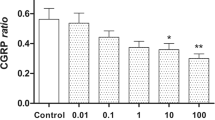Abstract
Antidromic stimulation of vagal sensory nerves is known to produce plasma extravasation in the rat trachea. This neurogenic inflammation is thought to be mediated by substance P or other tachykinins released from sensory nerve endings. We sought to determine whether calcitonin gene-related peptide (CGRP), which is also released from sensory nerve endings, can potentiate substance P-induced plasma extravasation in the rat trachea. To accomplish this, we measured the amounts of Evans blue dye extravasated into the trachea after intravenous injections of substance P alone and combined with CGRP. We found that when substance P and CGRP were injected together, the amount of plasma extravasation produced in the trachea was substantially greater than the amount produced when substance P was injected alone. This potentiation was critically dependent on the dosage of CGRP and was not observed when relatively high dosages were used. We also found that CGRP had a potent hypotensive effect and speculate that reduced blood pressure may account for the lack of potentiation observed at the higher CGRP dosages. Based on these findings, we conclude that CGRP can potentiate substance P-induced plasma extravasation in the rat trachea and may therefore play a role in modulating neurogenic inflammation of the airways.
Similar content being viewed by others
References
Barnes PJ (1991) Sensory and inflammatory peptide receptors in airways. In: Agrawal DK, Townley RG (eds) Inflammatory cells and mediators in bronchial asthma. CRC Press, Boca Raton, FL, pp 207–221
Brain SD, Williams TJ (1985) Inflammatory oedema induced by synergism between calcitonin gene-related peptide (CGRP) and mediators of increased vascular permeability. Br J Pharmacol 86:855–860
Brain SD, Williams TJ, Tippins JR, Morris HR, MacIntyre I (1985) Calcitonin gene-related peptide is a potent vasodilator. Nature 313:54–56
Brain SD, Williams TJ (1989) Interactions between the tachykinins and calcitonin gene-related peptide lead to the modulation of oedema formation and blood flow in rat skin. Br J Pharmacol 97:77–82
Brokaw JJ, McDonald DM (1988) Neurally mediated increase in vascular permeability in the rat trachea: onset, duration, and tachyphylaxis. Exp Lung Res 14:757–767
Chung KF, Rogers DF, Barnes PJ, Evans TW (1990) The role of increased airway microvascular permeability and plasma exudation in asthma. Eur Respir J 3:329–337
Fuller RW, Conradson T-B, Dixon CMS, Crossman DC, Barnes PJ (1987) Sensory neuropeptide effects in human skin. Br J Pharmacol 92:781–788
Gamse R, Saria A (1985) Potentiation of tachykinin-induced plasma protein extravasation by calcitonin gene-related peptide. Eur J Pharmacol 114:61–66
Jancsó N, Jancsó-Gábor A, Szolcsányi J (1967) Direct evidence for neurogenic inflammation and its prevention by denervation and by pretreatment with capsaicin. Br J Pharmacol 31:138–151
LeVeen HH, Fishman WH (1947) Combination of Evans blue with plasma protein: its significance in capillary permeability studies, blood dye disappearance curves, and its use as a protein tag. Am J Physiol 151:26–33
Lundberg JM, Brodin E, Saria A (1983) Effects and distribution of vagal capsaicin-sensitive substance P neurons with special reference to the trachea and lungs. Acta Physiol Scand 119:243–252
Lundberg JM, Franco-Cereceda A, Hua X, Hnkfelt T, Fischer JA (1985) Coexistence of substance P and calcitonin gene-related peptide-like immunoreactivities in sensory nerves in relation to cardiovascular and bronchoconstrictor effects of capsaicin. Eur J Pharmacol 108:315–319
Lundberg JM, Saria A (1982) Capsaicin-sensitive vagal neurons involved in control of vascular permeability in rat trachea. Acta Physiol Scand 115:521–523
Maggi CA, Giuliani S, Santicioli P, Abelli L, Meli A (1987) Visceromotor responses to calcitonin gene-related peptide (CGRP) in the rat lower urinary tract: evidence for a transmitter role in the capsaicin-sensitive nerves of the ureter. Eur J Pharmacol 143:73–82
Martling C-R, Saria A, Fischer JA, Hnkfelt T, Lundberg JM (1988) Calcitonin gene-related peptide and the lung: neuronal coexistence with substance P, release by capsaicin and vasodilatory effect. Regul Peptides 20:125–139
Pernow B (1985) Role of tachykinins in neurogenic inflammation. J Immunol 135:812s-815s
Rogers DF, Belvisi MG, Aursudkij B, Evans TW, Barnes PJ (1988) Effects and interactions of sensory neuropeptides on airway microvascular leakage in guinea-pigs. Br J Pharmacol 95:1109–1116
Rogers DF, Boschetto P, Barnes PJ (1989) Plasma exudation: correlation between Evans blue dye and radiolabeled albumin in guinea pig airways in vivo. J Pharmacol Methods 21:309–315
Saria A, Lundberg JM (1983) Evans blue fluorescence: quantitative and morphological evaluation of vascular permeability in animal tissues. J Neurosci Methods 8:41–49
Siren A-L, Feuerstein G (1988) Cardiovascular effects of rat calcitonin gene-related peptide in the conscious rat. J Pharmacol Exp Ther 247:69–78
Wahlestedt C, Beding B, Ekman R, Oksala O, Stjernschantz J, Hakanson R (1986) Calcitonin gene-related peptide in the eye: release by sensory nerve stimulation and effects associated with neurogenic inflammation. Regul Peptides 16:107–115
Wallengren J, Håkanson R (1987) Effects of substance P, neurokinin A and calcitonin gene-related peptide in human skin and their involvement in sensory nerve-mediated responses. Eur J Pharmacol 143:267–273
Williams TJ (1982) Vasoactive intestinal polypeptide is more potent than prostaglandin E2 as a vasodilator and oedema potentiator in rabbit skin. Br J Pharmacol 77:505–509
Zar JH (1984) Biostatistical Analysis, 2nd ed. Prentice-Hall, Englewood Cliffs, NJ, pp 185–205
Author information
Authors and Affiliations
Additional information
Offprint requests to: J.J. Brokaw
Rights and permissions
About this article
Cite this article
Brokaw, J.J., White, G.W. Calcitonin gene-related peptide potentiates substance P-induced plasma extravasation in the rat trachea. Lung 170, 85–93 (1992). https://doi.org/10.1007/BF00175980
Accepted:
Issue Date:
DOI: https://doi.org/10.1007/BF00175980




